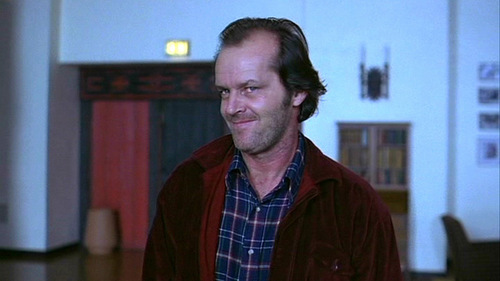 |
| Figure 1: Theatrical Poster (IMDb) |
Another Kubrickian classic based on a novel of the same name by Stephen King The Shining is a dark, surreal and supenseful look the maddening effects of isolation along with maybe-or-maybe not supernatural atmosphere.
The film starts off feeling like a King setting - mountains and pine forests in rural Colorado cut by a ribbon of asphalt as we see a Volkswagon beetle drive up to the magnificent-looking Overlook Hotel. A huge 1920s neoclassical hotel building built on the mountain slopes. After passing though it's doors Jack Torrance (Jack Nicholson) talks about a job offer he recieved as winter caretaker. The interviewer telling him of an unpleasant event that, according to Jack, his supervisors neglected to mention.
When Jack agrees to the job, we cut to Danny (his son, palyed by Danny Lloyd) looking in the mirror talking to "Tony", an entity Danny claims lives in his finger that tells him things. And by "tells him things" the film means either Danny talking to himself in a raspy voice... or experiencing visceral images via hard-cut with the occasional jump to see Danny's reaction. All in all very disturbing thing for a child to expereince. We get a further glypse of this power when Dick Hallorann, the head chef, telepathically asks him "Do you want some ice cream, Doc?" Dick asks him later and Danny agrees, and we get more exposition - as Dick and apparently Danny are capable of "shining", a form of wordless communication between two people. Kubrick's version of the tale has less of a supernatural element to it than the original King novel so it could be that Dick is describing one possible interpretation of the kind of close bond some people form where discussions can be performed with expression and emotion rather than words, in a sense "knowing" what the other person is thinking based on how much you two know each other.
 |
| Figure 2: Jack's reaction to Wendy accusing him of hurting Danny sells well that the family is breaking down and things are getting very strange. (Portilla, 2012 |
 |
| Figure 3: One of Nicholson's...less terror-inducing crazyfaces. (Fan M, 2013) |
 |
| Figure 4: Four months in an empty mansion? Even a jerk like Dilbert Grady would make good conversation by then. (Cinematheia, 2014) |
Bibliography
- http://www.imdb.com/title/tt0081505/
- Variety Staff 1979; Review: 'The Shining'; Variety; available at http://variety.com/1979/film/reviews/the-shining-1200424592/ (last accessed 9th December 2014)
- Schickel, R. 1980; Cinema: Red Herrings and Refusals; Time; available at http://content.time.com/time/magazine/article/0,9171,924179-1,00.html (last accessed 9th December 2014)
- Nathan, I., 2006; The Shining; Empire; available at http://www.empireonline.com/reviews/reviewcomplete.asp?FID=132700 (last accessed 9th December 2014)
Image Reference
- Figure 1: IMDb, unknown; [Theatrical Poster] ; The Shining (1980) Poster; available at http://ia.media-imdb.com/images/M/MV5BODMxMjE3NTA4Ml5BMl5BanBnXkFtZTgwNDc0NTIxMDE@._V1_SY317_CR1,0,214,317_AL_.jpg
- Figure 2: Portilla, D., 2012; [Jack's reaction to Wendy accusing him of hurting
Danny sells well that the family is breaking down and things are
getting very strange.] The Shining 1; available at http://ad009cdnb.archdaily.net/wp-content/uploads/2012/11/1352715665-the-shining-1-528x302.jpg - Figure 3: Fan M, 2013; [One of Nicholson's...less terror-inducing crazyfaces.] The Shining; available at http://images5.fanpop.com/image/photos/25500000/The-Shining-the-shining-25556953-500-281.jpg
- Figure 4: Cinametheia, 2014; [Four months in an empty mansion? Even a jerk like
Dilbert Grady would make good conversation by then.]; available at http://www.cinematheia.com/wp-content/uploads/2014/01/0001.jpg

:D Another thoughtful review.... good stuff!
ReplyDelete